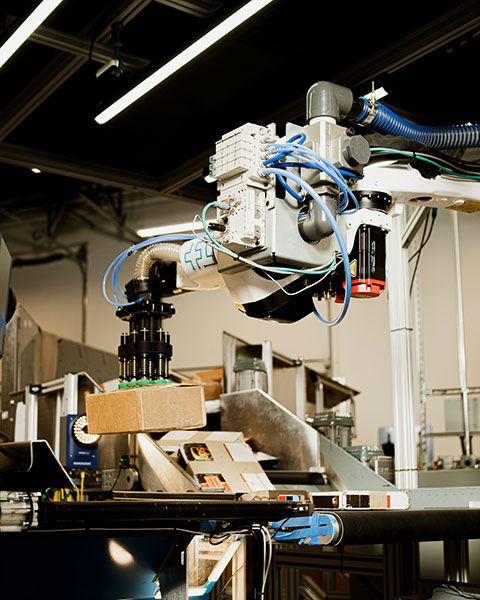Warehouse automation can meet 24/7 demand and improve throughput, offering a scalable solution for increasing e-commerce needs.
It’s difficult to over-emphasize the impact e-commerce has had on retail. Modern distribution and delivery cycles have fundamentally changed in the past five years, expanding drastically to keep pace with growing consumer demand. Experts predict that worldwide e-commerce sales will reach $6.3 trillion in 2024, a 9.4% increase from 2023 — and a nearly $1.5 trillion jump from 2021.
These trends are enlightening. They indicate that e-commerce retail has significant staying power, contrary to the belief of some pandemic-era spectators. Consumers — especially Gen Z and millennial consumers — enjoy the freedom of ordering goods on the go and from their couch. Additionally, rising e-commerce suggests that our current model of distribution and fulfillment is inadequate.
Most warehouse systems aren’t built to accommodate extreme levels of digital spending. Typically, warehouses are only equipped to fulfill timely, expected restock orders for physical stores. Perhaps warehouse staff expect a busy holiday season — but maintaining high staffing levels and maintenance during “slow” seasons is unrealistic. The result is habitually delayed shipments.
But there’s another way. By adopting warehouse automation and robotics, leaders can meet swelling volumes of online spending and e-commerce.
The global industrial robotics industry is booming. According to McKinsey, 23% of retail and consumer goods leaders expect to invest more than $500 million in automation over the next five years. Another 23% expect to invest between $100 and $499 million.
Soaring investments in warehouse robotics reflect changing consumer behavior. In 2022, about 16.5% of all consumer purchases were returned, representing $816 billion of merchandise. Customers expect these returns to be free — and shipping timelines to be short. Nearly half of modern consumers have abandoned a cart because an item’s expected shipping timeline was too long, and more than half (53%) say they’re willing to pay more for faster delivery.
Maintaining speedy returns and same-day delivery is a tricky business. It requires retailers to practice extreme efficiency on the warehouse floor, including day-and-night fulfillment. Automation provides a viable answer to the conundrum of skyrocketing consumer expectations. Warehouse robots operate 24/7 and require minimal maintenance, completing routine tasks like depalletization, parcel handling and sorting. They can operate 24 hours a day and seven days a week with minimal maintenance.
Moreover, modern automation enables robots to adapt to an organization’s fluctuating e-commerce strategy. Say a retailer amends its return window from 14 to 30 days. This decision simultaneously increases gross purchase and return volume, necessitating increased throughput on the warehouse floor. Because returns pallets are mixed, robots must be prepared to handle “exceptions” — that is, instances of picking and packing that deviate from programmed expectations. In this case, human-in-the-loop software is critical for expediently addressing exceptions to meet (and even exceed) expected throughput.
A human-first approach to robotics automation is crucial on the warehouse floor. It enables better efficiency, operations, cost-savings and satisfaction for consumers and employees.

Implementation challenges, including high retrofitting costs, technical difficulties and robotics limitations, can hinder warehouse operations and productivity if improperly managed. However, obstacles should not dissuade leaders from pursuing robotics automation solutions. The future of distribution and logistics is robotic — at least, in part. Therefore, retail leaders must identify and surmount early challenges to implementation.
The initial cost of advanced robotics and automation integration can be proscriptive, especially for small to medium-sized enterprises. The legacy business model for warehouse automation is particularly cost-prohibitive because it requires organizations to own, operate and maintain robots in-house. But this model is outdated.
Advances in robotics as a service (RaaS) have permitted organizations to scale their automation needs far more effectively, integrating (and decomissioning) robots as needed in response to market fluctuations. A SaaS-based approach to warehouse robotics benefits less technically equipped organizations because the responsibility of upgrading and maintaining robots falls on a third party. In some cases, even the responsibility of human supervision can be outsourced.
Warehouses are complex environments. The process of retrofitting a space for robots can be arduous, and digital workflow adjustments are often equally complex. Although advanced robots can interact with various shelving systems and operate in various environments, certain modifications may be necessary, including building layout adjustments that optimize traffic and goods flow. Companies can negate cost barriers by:
The speed and availability of e-commerce are influencing retail and consumer expectations. To keep pace, companies simply must invest in warehouse automation and robotics. The ultimate benefits of doing so include increased efficiency, cost-savings and improved customer satisfaction. (And these benefits are multiplied when retailers maintain a strong focus on human supervision and robotic collaboration.)
The long-term benefits of warehouse automation far outweigh capital expenditures (CapEx). Automation is the next evolution in distribution and fulfillment — retailers evolving now will ultimately lead the way.

About the Author
Erik Nieves is co-founder and CEO of Plus One Robotics, a software company developing 3D and AI-powered vision software for robots in logistics automation. Prior to Plus One, Erik was Technology Director for Yaskawa Motoman Robotics where he was responsible for the technology roadmap and emerging applications. During his 25+ year tenure at Yaskawa, Erik held a variety of leadership positions in the U.S. and abroad. Erik serves on the board at Robotics Industries Association (RIA) and is a frequent speaker and contributor to public policy on robotics.
In this episode, I sat down with Beejan Giga, Director | Partner and Caleb Emerson, Senior Results Manager at Carpedia International. We discussed the insights behind their recent Industry Today article, “Thinking Three Moves Ahead” and together we explored how manufacturers can plan more strategically, align with their suppliers, and build the operational discipline needed to support intentional, sustainable growth. It was a conversation packed with practical perspectives on navigating a fast-changing industry landscape.